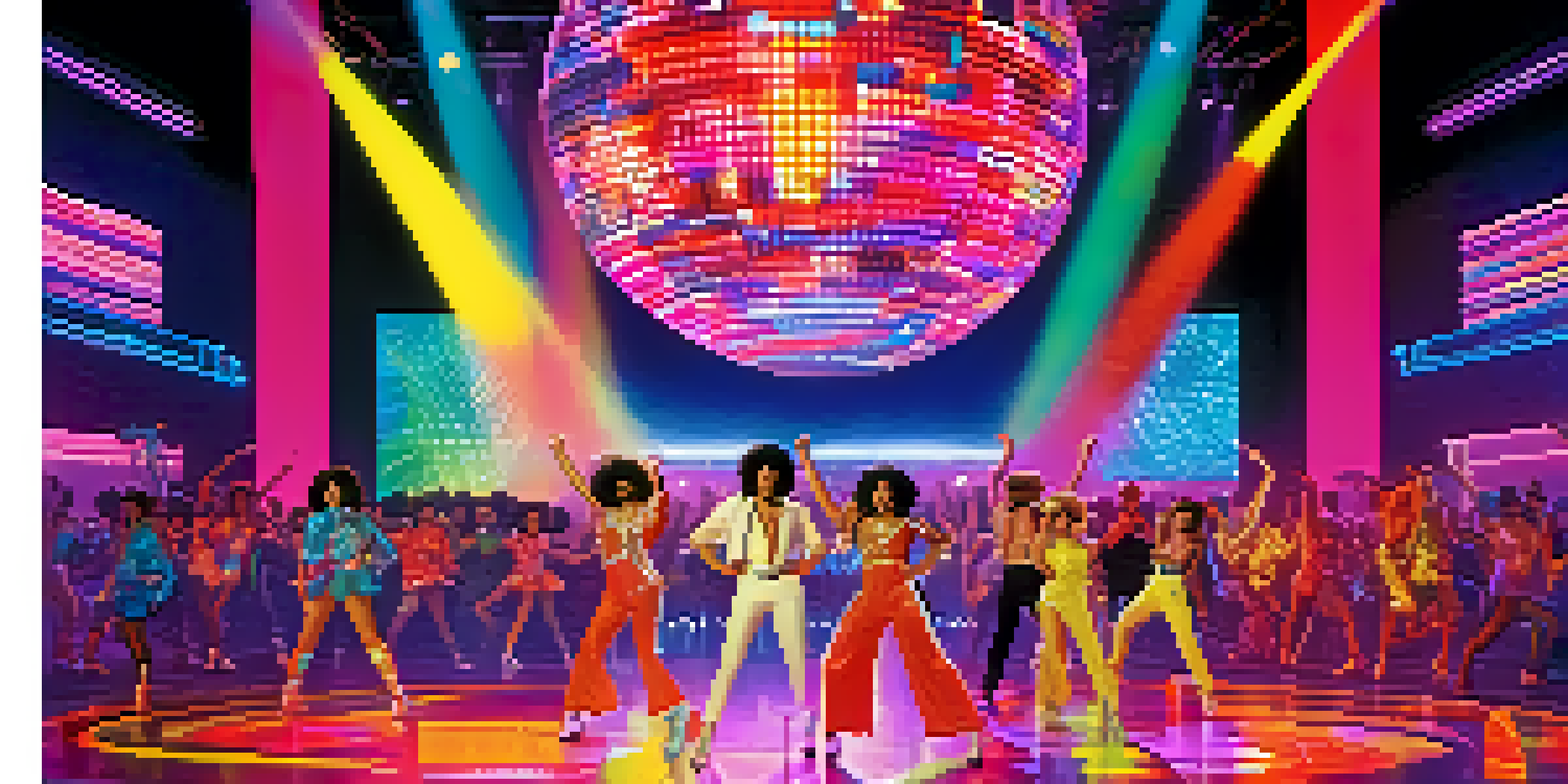The Evolution of Music Videos: From MTV to Digital Platforms

The Birth of Music Videos: MTV's Impact
When MTV launched in 1981, it revolutionized how we experienced music. Suddenly, artists were not just focusing on their sound, but also on their visual presentation. Music videos became a crucial part of an artist's identity, making memorable first impressions through captivating visuals.
Music videos have become an essential part of the artist's identity, creating memorable first impressions through captivating visuals.
MTV's format allowed viewers to connect with their favorite songs on a deeper level. Iconic videos like Michael Jackson's 'Thriller' set the stage for high production values and storytelling in music. This shift led to the rise of the music video as an art form, where visuals were as important as the music itself.
As MTV dominated the airwaves, it shaped pop culture and influenced how music was marketed. Artists began to collaborate with renowned directors, turning music videos into mini-movies that told compelling stories. The combination of music, dance, and imagery forged a new way for fans to engage with their favorite artists.
The Golden Age of Music Videos in the '80s and '90s
The '80s and '90s are often referred to as the golden age of music videos. During this time, innovative techniques and styles emerged, pushing the boundaries of creativity. Artists like Madonna and Prince used their videos to challenge social norms and express their individuality.

This era also saw the introduction of special effects and elaborate sets, making music videos visually stunning. Directors like David Fincher and Spike Jonze brought a cinematic flair to the medium, resulting in memorable visuals that complemented the music. With each new release, fans eagerly anticipated what would come next.
MTV Revolutionized Music Videos
MTV's launch in 1981 transformed music by making music videos essential for artists' identities and fan engagement.
Moreover, popular shows like 'Total Request Live' (TRL) gave fans a platform to vote for their favorite videos, creating a sense of community. This engagement not only boosted an artist's popularity but also made music videos a staple of youth culture, sparking conversations and influencing fashion trends.
The Decline of Traditional Music Videos in the 2000s
As the new millennium approached, the music video landscape began to shift. The rise of the internet and digital platforms changed how audiences consumed music, leading to a decline in traditional music video viewership. With the introduction of platforms like YouTube in 2005, music videos became instantly accessible, but this also altered their significance.
The rise of user-generated content has democratized music videos, allowing fans to showcase their creativity and feel connected to the music.
Artists started to prioritize viral content over polished music videos, often opting for shorter clips that could quickly capture attention. The focus shifted from elaborate storytelling to creating shareable moments that could spread across social media. This change created a more informal, relatable approach to music videos.
However, as the quality of production dipped, some fans longed for the artistry of earlier videos. While the traditional music video might have waned, the creativity of artists continued to evolve, leading to new forms of visual storytelling that adapted to the digital age.
The Rise of User-Generated Content and DIY Videos
With the advent of smartphones and social media, user-generated content took center stage in the music video scene. Artists began encouraging fans to create their own interpretations of songs, leading to an explosion of DIY videos that showcased personal creativity. This trend not only democratized music videos but also fostered a sense of community among fans.
Platforms like TikTok and Instagram became breeding grounds for short, catchy clips that could go viral overnight. Artists capitalized on this trend by creating challenges or hashtags around their songs, inviting fans to participate and share their videos. This interactive approach allowed fans to feel more connected to the music and the artist.
Social Media Redefines Music Videos
The rise of social media platforms has shifted the focus of music videos towards viral, shareable content that emphasizes community interaction.
While some traditionalists may miss the polished production of earlier decades, this new wave of creativity highlights the power of community in the digital age. It has redefined what a music video can be, emphasizing authenticity and personal expression over high-budget productions.
The Role of Streaming Services in Music Video Distribution
As streaming services like Spotify and Apple Music gained popularity, they began incorporating music videos into their platforms. This integration allowed fans to enjoy their favorite songs alongside visually engaging content, providing a more immersive experience. Artists now had the opportunity to showcase their videos directly to their audience, bypassing traditional media channels.
Moreover, streaming platforms opened up new avenues for artists to monetize their content. Instead of relying solely on television airplay or YouTube ad revenue, they could earn through subscriptions and direct-to-consumer sales. This shift has empowered artists, giving them more control over their distribution and marketing strategies.
The result is a more dynamic music video landscape, where artists can experiment with formats and styles. Whether it's a full-length video, a lyric video, or behind-the-scenes content, the possibilities are endless. Streaming services have not only changed how we consume music but have also reshaped how artists present their work.
The Impact of Social Media on Music Video Trends
Social media has significantly influenced music video trends, shaping what resonates with audiences today. Artists now have to consider how their videos will perform on platforms like Instagram, TikTok, and Twitter, often tailoring their content to fit these formats. This has resulted in more visually striking and brief videos that capture attention quickly.
Virality has become a key goal, with artists aiming to create buzz around their releases. Memorable hooks, catchy choreography, and relatable themes are often prioritized to encourage sharing. The emphasis on shareable content has transformed music videos into tools for engagement and brand-building, rather than just promotional materials.
Future Trends in Music Videos
Emerging technologies like VR and AR promise to create immersive music video experiences, while personalization and interactivity will deepen artist-fan connections.
As a result, the traditional narrative-driven music video is often sidelined in favor of bite-sized, impactful clips. This evolution highlights the need for artists to adapt to changing consumer behaviors and preferences, ensuring their music remains relevant in an ever-evolving digital landscape.
The Future of Music Videos: Trends to Watch
Looking ahead, the future of music videos is likely to be shaped by technological advancements and shifting audience preferences. With the rise of virtual reality (VR) and augmented reality (AR), we may soon see immersive experiences that allow fans to engage with music in entirely new ways. Imagine stepping into a virtual concert or exploring a 360-degree music video—exciting possibilities await!
Additionally, the trend towards personalization will likely continue. Artists may experiment with interactive videos that allow viewers to choose their own paths or outcomes, creating a more engaging experience. This emphasis on interactivity could redefine the relationship between artists and fans, fostering deeper connections.

As the landscape evolves, one thing is clear: music videos will remain a vital part of the music industry. Whether through innovative technology or community-driven content, the art of music videos is sure to adapt, reflecting the ever-changing dynamics of how we consume and connect with music.